Let’s talk about creeping thyme, a perennial herb. Don’t worry; there’s nothing creepy about it — the plant just got its moniker from its creeping growth habit! This tiny creeper is frequently used as ground cover to shade sunny areas of the yard. However, gardeners opting for thyme as ground cover often wonder, is creeping thyme invasive or not?
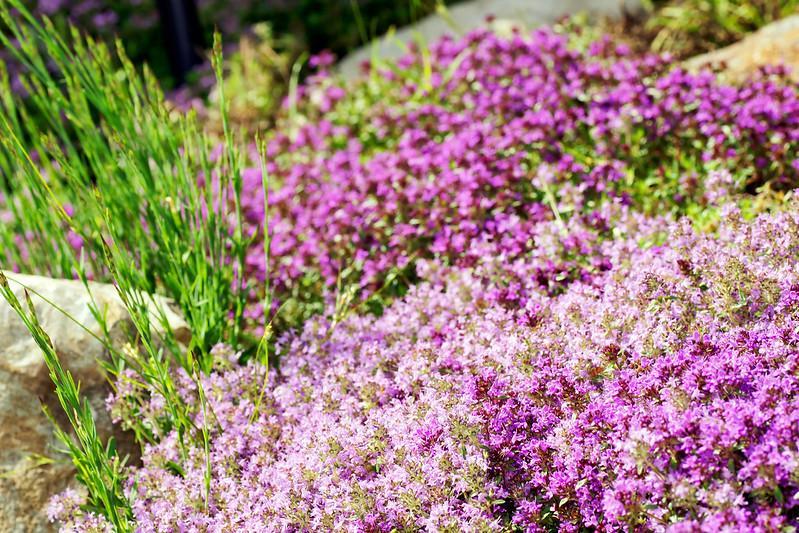
Often referred to as “Mother of Thyme,” creeping thyme is a low-maintenance, wide-spreading thyme variety.
Although you won’t be able to eat creeping thyme like its savory relative, the herb does have a delightful aroma. Still, however, a lot of people are hesitant to plant creeping thyme in their homes since there is a chance that it could become invasive and suffocate the other plants in the yard. So, should you plant it, and whether there’s a way to control its spread?
While creeping thymes do have unique growth tendencies, this does not necessarily make them invasive. However, it would help if you do not let them spread freely, either. Pruning these plants is essential. The woody stalks of invasive thyme can be a real eyesore in landscape design. So, if you want to keep your garden space looking good, regularly prune creeping thyme to keep its spread under check.
Continue reading to learn more about this lovely herb, including how to plant and control its growth in your yard and maintain its attractive appearance.
What Are Creeping Thymes?
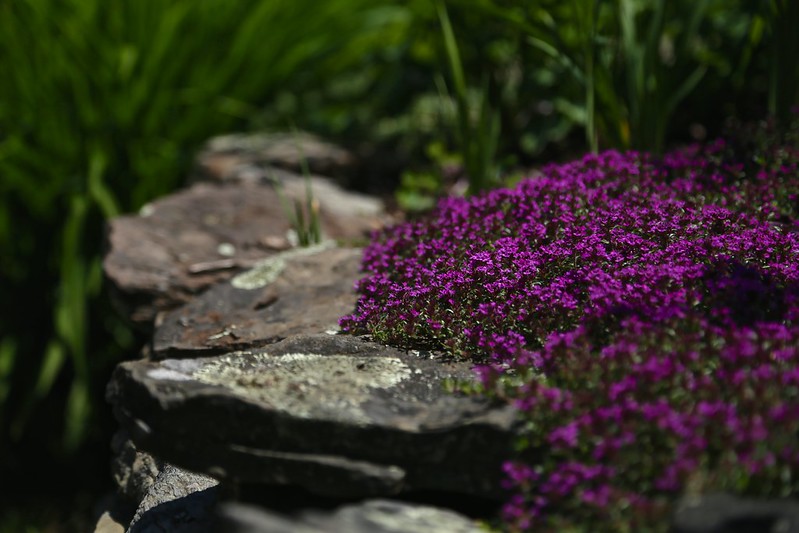
The creeping thyme is a low-lying evergreen shrub that grows slowly and creeps along the ground.
The Creeping Thyme plant, scientifically known as Thymus serpyllum, is a perennial herb that is a member of the family Lamiaceae, which also includes mint. In general, the maximum height that these plants can attain is approximately six inches above the ground.
Flower production on the vines often begins in the spring or during the first few weeks of summer, whichever comes first. The kinds of blooms that are produced by creeping thyme will vary according to the species that you have growing.
Pollinators of all kinds are drawn to these flowers, but butterflies, in particular, reap the benefits of their presence.
The foliage of creeping thyme is typically quite delicate in texture and can swiftly spread and cover an entire garden. Therefore, creeping thyme plants are often an excellent choice for embellishing rock gardens, walks, and stepping stones.
However, you could also use them as a border plants for your garden. Having said that, these plants have the propensity to flourish in generally mild settings, so if you reside in a location characterized by extremes, this option might not be the best one for you.
But, if you successfully grow them, you will be in for a treat. These plants emit a fragrance that you are going to enjoy very much. In point of fact, the aroma is highly reminiscent of the thyme that the vast majority of people put in their food.
Nevertheless, here are some more quick facts about creeping thyme:
| Other Names | Wild thyme, Elfin Thyme, Breckland thyme |
| Scientific Name | Thymus serpyllum |
| Bloom Time | Summer |
| Flower Color | Pink, white, purple |
| Mature Size | 3 to 6 inches tall and 5 to 15 inches wide |
| Native To | Europe |
| Plant Type | Herbaceous, perennial |
| Ideal Soil PH | Slightly alkaline |
| Ideal Soil | Sandy and well-drained |
| Sunlight Needs | Full |
| Hardiness Zones | USDA 4 to 9 |
Related: Lavenders: Helpful Tips on Growing These Plants In Pots and Containers
How To Plant Creeping Thymes?
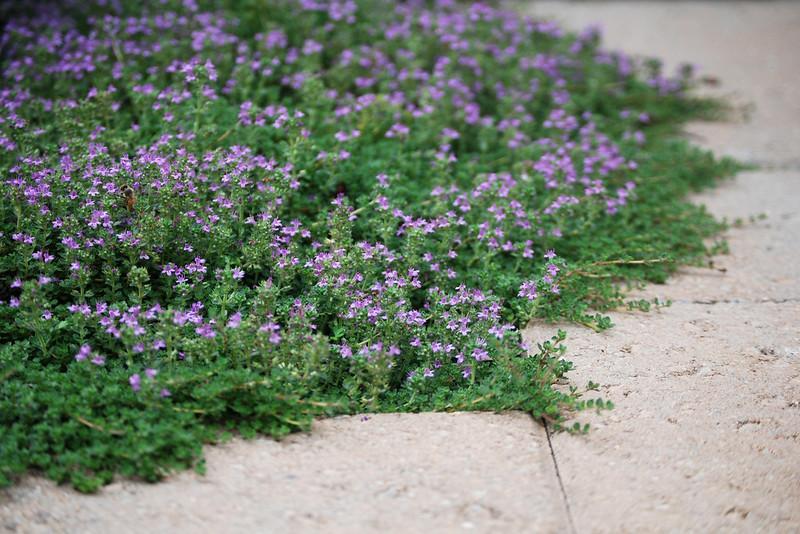
Creeping thyme plants grow best in well-draining soil with a neutral to slightly alkaline pH.
The ideal conditions for growing creeping thyme are those that provide the plant with around four hours of sunlight per day.
When planting, wait until late spring or early summer when frost danger has passed. Some people believe that the higher temperatures and longer days of spring assist plants in rapidly gaining new growth.
Whereas others believe that the cooler temperatures and shorter days of fall allow plants to bunker down and invest more energy in their roots. Both strategies seem to work just fine. Creeping thyme can be grown from either seeds or cuttings taken from the stem.
When growing in containers, use potting compost that is based on soil and mix in some coarse grit to improve drainage. Even though these little friends are incredibly hardy, being exposed to an excessive amount of water can be harmful. Therefore, when the creeping thyme plant is developing, the soil should be kept damp but not wet.
This is because the developing plant is prone to root drowning and edema. The type and usage of the plants determine the placement and distance between them.
For example, creeping thyme that will be used as a ground cover needs to be planted at a considerably greater distance between and around 12 to 18 inches.
On the other hand, the creeping thyme that is being used to fill the spaces between the flagstones has to be spaced approximately four to six inches apart.
Caring For Creeping Thymes
Once it has become established, creeping thyme does not require regular maintenance other than the occasional pruning of more mature plants. Nevertheless, check out the fundamental basics below, and read for more specifics on caring for this plant!
Temperature & Humidity Requirements
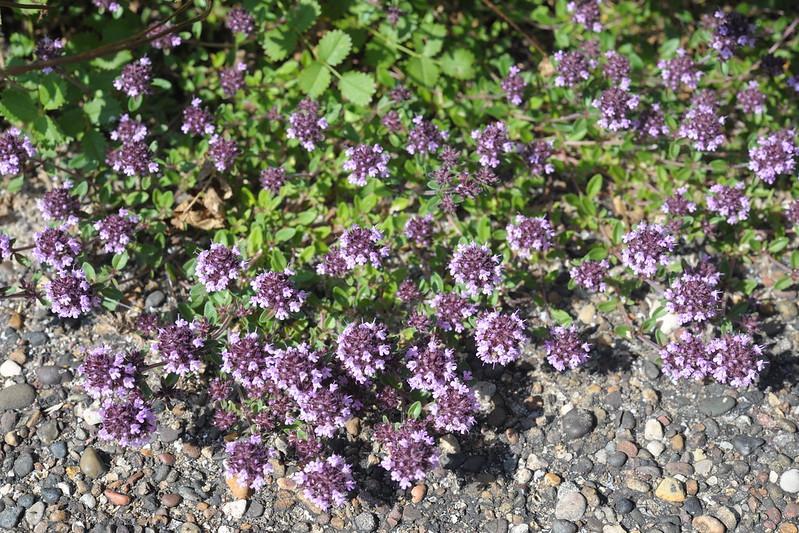
It prefers spring-early summer temperatures of 68 to 86 °F (20 to 30 °C).
Thyme plants, as a rule, do not thrive in environments with a high level of humidity. If you reside in an area with high relative humidity, the foliage and flowers of the creeping thyme are more susceptible to harm. Sand or gravel could be placed around the plant’s base in order to prevent it from coming into contact with moist soil.
When the weather changes to become cooler and drier, the affected plants should begin to recover. However, remember that these plants cannot withstand temperatures below freezing, so you should wait until the late spring or early summer to transfer them outside.
In general, the temperature range of 65 to 85 degrees Fahrenheit is good for the growth of creeping thyme. Several types can withstand temperatures as low as -30 degrees Fahrenheit. However, once freezing temperatures establish themselves, it will cease its development, regress, and enter a dormant state.
Related: Growing Rosemary From Cuttings: The Complete Guide and Know-Hows
Fertilizer Requirements
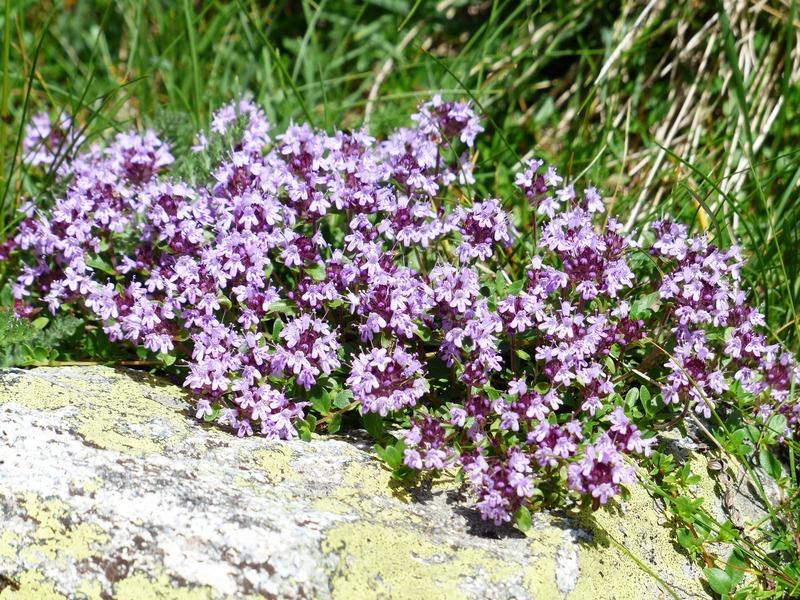
For the most part, creeping thyme does not require plant food or fertilizer to thrive.
If the soil in which it is growing has been adequately prepared, creeping thyme shouldn’t need to be fed. However, if the soil is poor, you can make up for the lack of nutrients by applying a fertilizer with a delayed release just once at the start of each new growing season.
The same is true for plants that are planted indoors; all they require is a side-dressing of compost in the spring. In addition, if you observe that the plant’s leaves are expanding but the flowers are not, you can correct this imbalance by feeding the plant a balanced all-purpose plant food. However, make sure not to fertilize the plants too heavily.
For example, using fertilizers high in nitrogen will result in stunted and feeble plants.
Lastly, to ensure that your plants receive the ideal amount of fertilizer, carefully follow the directions that are printed on the container.
Water Requirements
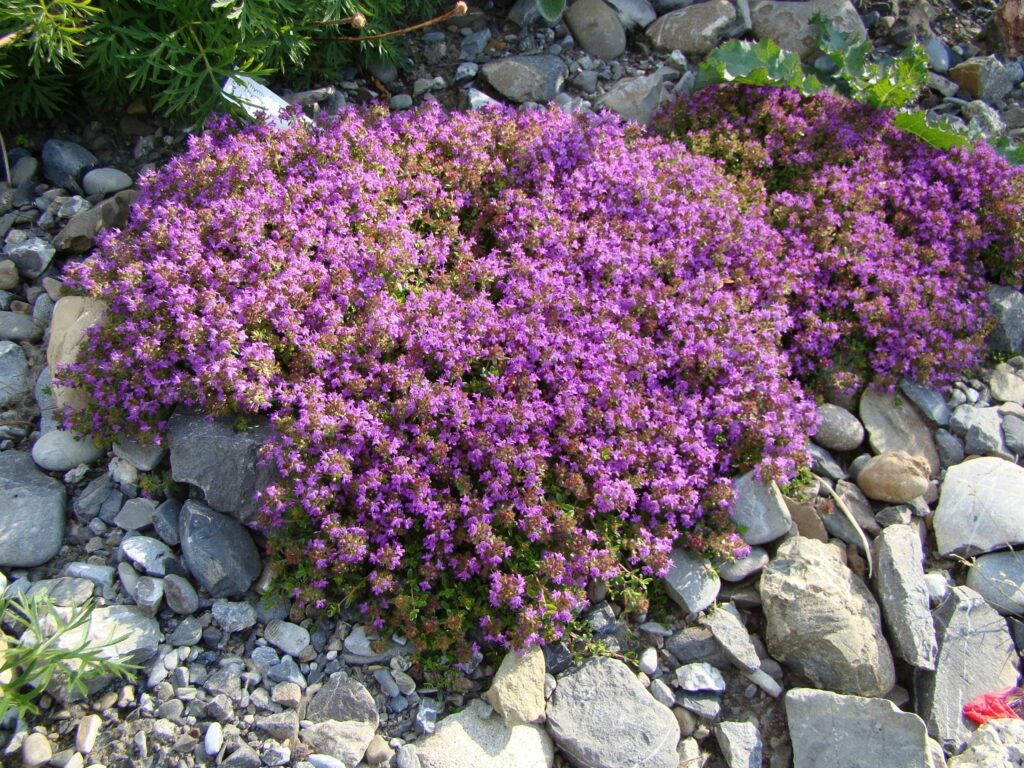
Creeping thyme prefers light watering and likes to dry between waterings.
When you use soils that drain quickly, such as those in which creeping thyme thrives, there is a risk that the plant could become dehydrated if you are not vigilant about keeping an eye on it. When freshly planted, creeping thyme has the highest watering requirements.
Therefore, maintain a moist environment while the plant’s roots are becoming established. However, established plantings of this plant that are resistant to drought should only be watered once every 10 to 14 days in order to remain in pristine form.
For some locations, rainfall alone is enough since creeping thyme is quite drought-tolerant. However, during the warm and dry summer months, it is essential to water thyme on a regular basis. Also, avoid over-watering the plant, especially during the fall and winter months, since this can cause the roots to rot and ultimately kill the plant.
Soil Requirements

Creeping thyme grows well in well-drained loamy soil but prefers sandy or rocky soil.
The presence of soil that drains adequately is essential for the growth of creeping thyme. If you want to keep this plant healthy, avoid growing it in soggy, heavy clay soil.
Similarly, it thrives in rocky, sandy, or loose soil but will also grow in loam if it drains well. It does poorly in conditions of moist clay. For optimal growth of creeping thyme, the pH of the soil should range from neutral to slightly alkaline. Lime can be used to help raise the pH of acidic or neutral soil by increasing the amount of hydrogen ions in the soil.
In general, the best yields are typically obtained in soils that are calcareous and light, have a pH that is relatively close to 7, and have excellent drainage.
Light Requirements
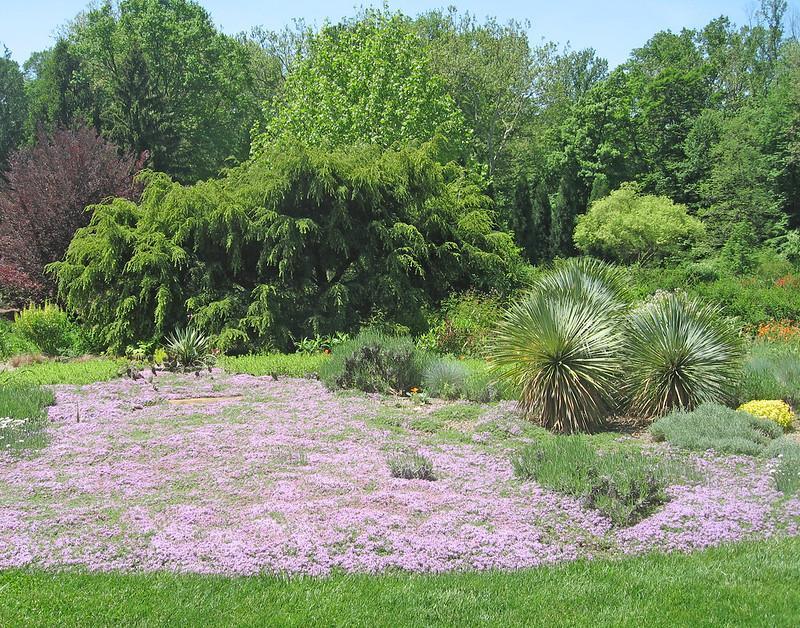
Creeping thyme prefers full sun but can also thrive in partial shade.
Since it evolved in the warm climates of the Mediterranean, creeping thyme requires at least six hours of sunlight per day. However, it is also able to endure when subjected to some shade. Therefore, if you are considering using creeping thyme as a ground cover plant in your garden, you should select a place that gets plenty of sunlight.
Pruning Requirements
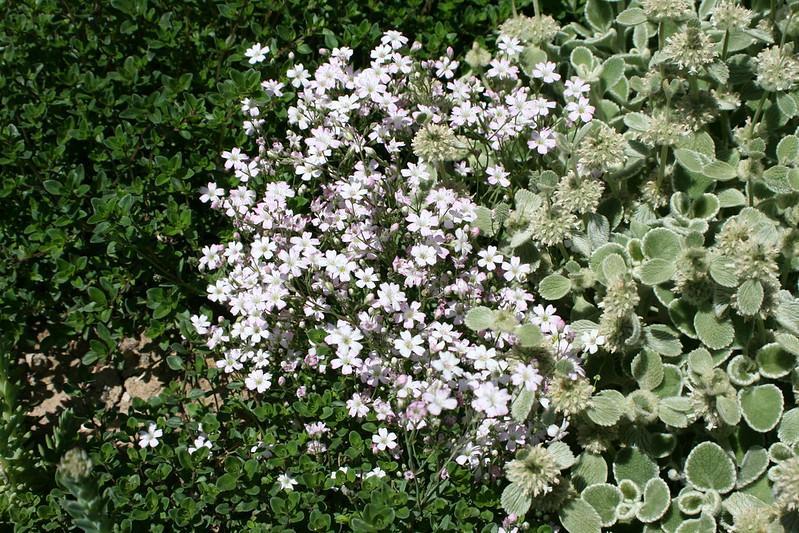
In the early spring, cut back the stems of your creeping thyme plant, so it is ready to grow again.
Once you start planting creeping thyme as a ground cover, the good news is that you won’t have to worry about having to mow the lawn anymore. However, instead of mowing, the other laborious activity that needs to be done is going to be pruning.
If you want to cultivate creeping thyme, regular pruning is the most laborious gardening chore you will need to complete. To retain its lustrous and healthy appearance, a lawn of creeping thyme must have two rounds of pruning performed on it throughout the year.
Therefore, prune the creeping thyme ground cover in the spring to retain a compact appearance and then again after a little when white blooms have faded away if more shaping is preferred.
In addition, creeping thyme needs to be divided and replanted every four to five years so that it can continue to spread. Creeping thyme fills the spaces left by cuttings to regrow thick and bushy after being pruned.
Creeping Thyme Propagation
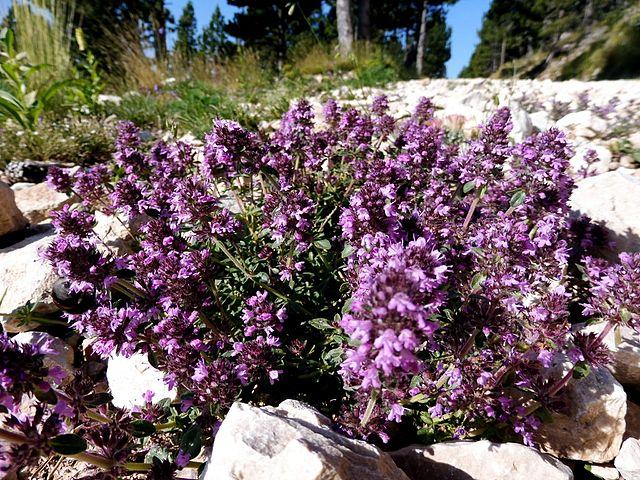
Creeping thyme is easily propagated from seeds, cuttings, and divisions.
Once established, it is a low-maintenance plant, but in the beginning, it does require some care. You have the option of planting seeds, using stem cuttings, and propagation by division, and either choice will result in luxuriant, verdant growth in no “thyme” at all (ha!).
Propagation By Division
When using the division method to propagate creeping thyme, start with a plant in good health, then carefully dig out the entire root ball and gently shake off as much soil as possible.
It should be cut into three or four portions, each of which should have enough roots and leaves to be able to develop independently from the others. To ensure a smooth re-establishment, divisions should be made either in the spring or the fall.
Propagation By Seedlings
Plant your seedlings in the spring, ensuring the roots are completely submerged in the earth, and the dirt surface reaches the plant’s base. Plants should be spaced approximately eight to twelve inches apart to allow them adequate room to develop to their maximum potential.
During the first two to three months of the plant’s life, you should water it well and consistently two to three times a week. This will help the roots grow established.
Propagation Via Seeds
After the risk of frost has passed, you can sow seeds. First, spread the seeds out across the area that has been allocated for planting and firmly press them into the earth, or plant two to three seeds in staggered rows at a distance of 12 to 18 inches.
After you have distributed the seeds across the area, be sure to give the plants a healthy dose of water so that they won’t be blown away by the wind or eaten by a curious animal.
Creeping Thyme Uses
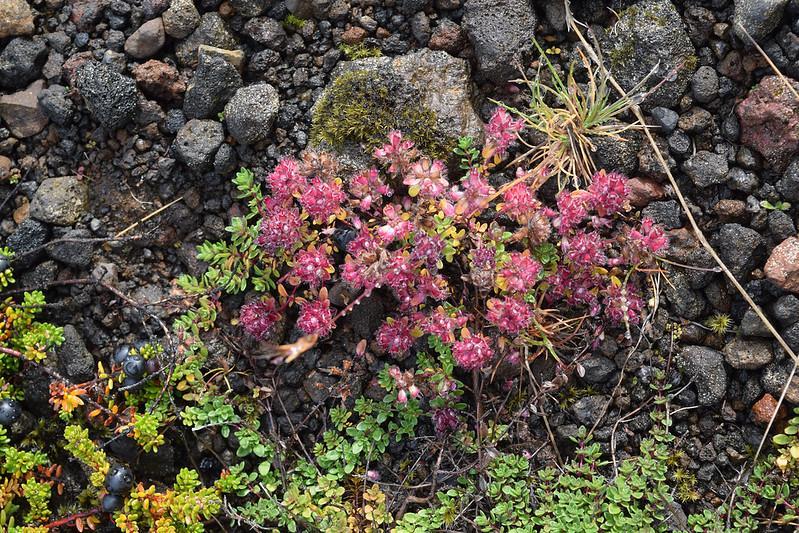
Flowering creeping thyme is cultivated for its aesthetic value, aromatic undertones, and hardiness.
Many people use creeping thyme for landscaping, but that’s not all it’s good for. For instance, if you’re the type of gardener who enjoys experimenting with different fragrances, you should know that the creeping thyme contributes a beautiful scent as it begins to grow.
However, you should seriously consider planting the creeping thyme to fill a bare spot in your yard. In addition, many gardeners use creeping thyme to fill the spaces between the stepping stones they plant all around the walkway.
This helps to give a more natural look. In addition, many gardeners find it helpful to use creeping thyme as an alternative to traditional grass. However, this is not exactly the best plan because it will be tough for you to stroll across the garden, particularly as it begins to flower.
Last but not least, utilizing creeping thyme in your garden is a fantastic choice if you are concerned about the growth of weeds in your garden, which could stunt the development of the flowers. In most cases, creeping thyme will suffocate any weeds that may have taken root in your garden, allowing you to keep your flower beds pristine.
Top Creeping Thyme Cultivars To Plant
There are many subspecies and variants of creeping thyme. In general, they are identical, yet, each variety of plant results in distinctive flowers and foliage. Therefore, let’s look at some of the different types so that we can assist you decide which one will work best in your yard!
“Archer’s Gold” Thyme
The ‘Archer’s Gold’ subshrub is a bushy evergreen subshrub that can grow up to 20 centimeters in height. It has small, lime-green leaves with a lemon-like aroma and tall spikes of tiny, pale lilac flowers in the late spring and early summer.
You can plant it along sidewalks or in the spaces between pavers, and then you can enjoy the aroma of lemon whenever the plant is brushed against. It thrives on somewhat acidic soil, rich in organic matter and slightly alkaline. Additionally, Archer’s Gold Thyme requires very little care and can survive extended periods of drought.
Doone Valley Thyme
The Doone Valley thyme is known for its highly lemon-scented, variegated yellow and green foliage. It forms mounds and is covered with pink flower clusters during summer.
Each plant may grow up to 18 inches tall and produce flower heads between three and four inches long and covered in pink blooms. If a flatter ground cover is required, cut these flowers after bloom. The lemon thyme variety known as ‘Doone Valley’ can grow in various soil types. However, for optimal growth, the soil should have a sandy texture.
White Creeping Thyme
White creeping thyme is a subspecies of wild creeping thyme, which is a perennial endemic to much of Europe and Northern Africa. You can use this tough creeper and groundcover as a “lawn,” along walkways, or even in the rock garden; it can take a little wear and tear.
It has the propensity to create mats, growing along the ground in a compact and creeping way, and it is a plant that can withstand harsh conditions. It is hardier than other varieties of creeping thyme and may live in USDA zone 2 without any problems.
Purple Carpet Thyme
The ‘Purple Carpet’ creeping thyme is resistant to frost, simple to cultivate, and requires little upkeep. It thrives in full sun on soils that range from moist to dry, are well-drained, and have a neutral to alkaline pH. Purple Carpet Creeping is covered with beautiful purple blooms at the stem tips from the beginning to the middle of summer.
Furthermore, throughout the summer, it forms a dense low mat fully covered in lavender-purple flowers, making it a lovely and well-liked ground cover.
English Thyme
English thyme is a low-growing plant whose leaves are fragrant. You can plant it as a ground cover; add it to rock gardens, graveled patches, and slopes, and it works wonderfully for xeriscapes and contemporary compositions.
English thyme is also known as garden thyme and common thyme. It can withstand a moderate degree of foot traffic, making it an ideal choice for filling the space between stepping stones and pavers due to its adaptability. It thrives in USDA zones 5 to 9 and has purple flowers, which is why it is commonly planted in gardens!
Pink Chintz Thyme
Pink Chintz Thyme, also known as Thymus Pink Chintz, is a compact, low-growing creeping thyme that features thick stems of woolly green foliage. It blooms in the middle of spring with an abundance of salmon-pink flowers. It is one of the thymes most tolerant of dry conditions but grows very well when it receives plenty of water.
In addition, the foliage is a fuzzy olive green color and produces a mat approximately 18 inches across. In the spring, you can propagate it by division. Mid- to late-summer is the best time to harvest cuttings from semi-hardwoods for this purpose.
Wooly Thyme
You just have to touch some plants, and one of those plants is a woolly thyme plant. Although commonly used as a decorative plant, woolly thyme also has medicinal and culinary applications. The woolly thyme will grow in any dry location and has good drainage.
Woolly thyme’s creeping and cascading growth habit is an asset to many landscape features, including patios, pathways, rock gardens, stone walls, and pond borders. The Woolly Thyme plant is in a league of its own. Wooly thyme reigns supreme in rock gardens. Lastly, this type is resistant to drought and can live in USDA hardiness zones 5 to 9.
Red Creeping Thyme
Red creeping thyme is a sun-loving, drought-tolerant herbaceous perennial of the mint family. This creeping perennial herb has blooms that are a deep lavender-red color and produces a stunning ground cover.
This evergreen subshrub grows to a height of just 5 centimeters and spreads out into a broad mat. Its tiny, fragrant, dark green leaves and clusters of 2-lipped, deep crimson flowers give the plant a distinct fragrance.
It is well-known for its ability to thrive in rocky soil and may develop to its full potential in any part of creeping thyme’s natural habitat. Additionally, this cultivar has the ability to grow its diameter to a maximum of 18 inches rapidly.
“Spicy Orange” Creeping Thyme
Thymus Spicy Orange is an evergreen groundcover that has a low growth rate. Its evergreen foliage, which is shaped like needles, is tolerant of light to moderate foot traffic, and the wonderfully spicy-orange fragrance is released with each step. Its low-growing habit makes it ideal for use between stepping stones, along the front of a border, or in a container.
Spicy Orange Thyme is a low-growing annual with a maximum height of 4 inches and a spread of 12 inches. It is recommended that individual plants be spaced roughly 10 inches apart when grown in masses or when used as a bedding plant.
Is Creeping Thyme Invasive?
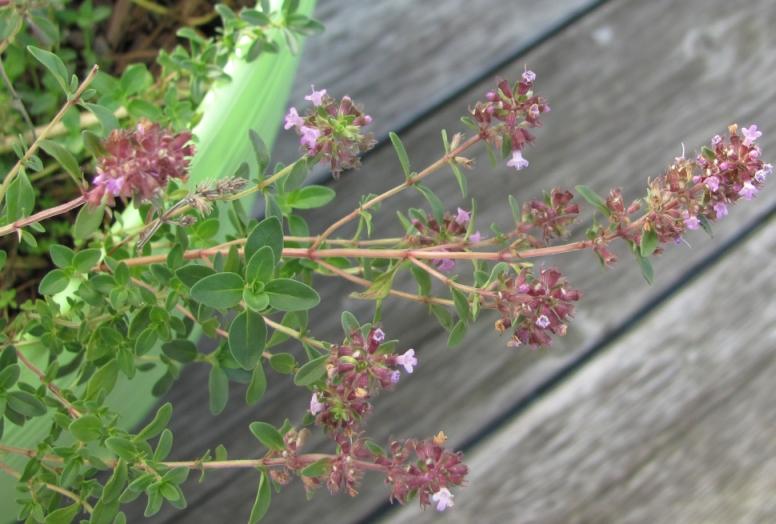
Have no fear; this attractive perennial herb is not considered invasive in any way.
So, let’s get right to the point: is creeping thyme truly an invasive species? The answer to that question is no; even though it can quickly spread throughout a garden, it won’t interfere with the growth of the other plants.
Therefore, if you are searching for an attractive ground cover, creeping thyme is an option you should consider seriously!
In most cases, creeping thyme takes about a year to become established, and it does not begin to spread until the second year. In addition, creeping thyme does not, in the majority of instances, prevent other plants from growing and thriving. It lacks that characteristic.
Your creeping thyme will, however, produce woody stems as time goes on. So, if this occurs, you must completely unroot the plant and replace it with a different kind.
How To Get Rid Of Creeping Thymes?
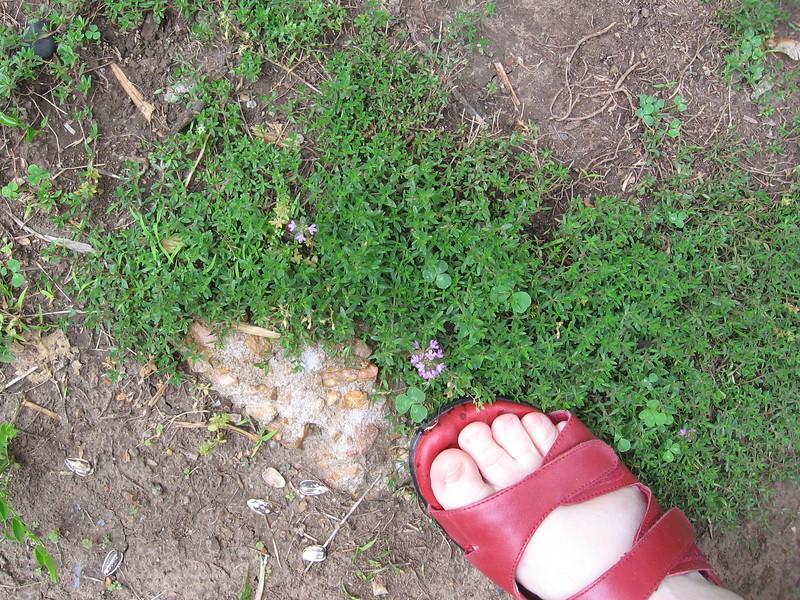
Use a shovel, hoe, and ax to loosen the dirt around the creeping thyme plant and remove the roots.
If you have been using creeping thyme as a ground cover, you may have some difficulty getting rid of it once it has become established. However, dig out the plant roots instead of using pesticides if you want to get rid of them. Here is how it works:
- Remove any large rocks or other rubbish from the creeping thyme.
- Use a riding mower or a push mower to mow down the invasive thyme.
- Use a broom rake to gather the snipped sprigs and throw them away.
- Use a shovel, hoe, and ax to loosen the dirt around the creeping thyme plant.
- The clumps of creeping thyme can be broken up by raking the soil with a bow rake.
- The thyme should be arranged in bunches on a soil screen set atop a wheelbarrow.
- You can loosen the soil around the root ball by hitting it on the screen.
- Go over the ground again, this time with a brush rake.
- When loading the soil screen, shovel a few handfuls at a time.
- In the end, replace the soil in the planting bed and rake it out again.
Final Thoughts
Even though it spreads quickly and has a rapid growth rate, we can safely say that creeping thyme is not invasive. It is nothing more than a quick grower with a lovely outlook and leaves that are comfortable to walk on. What else could you possibly want?
Frequently Asked Questions (FAQs)
Where is the best place to plant creeping thyme?
The ideal conditions for the growth of creeping thyme are found in zones 4 through 8. It requires soil that is alkaline and has adequate drainage. In addition, plant creeping thyme in nutrient-rich soil that is exposed to full sun and has good drainage. Additionally, ensure that it receives ample water until it becomes established.
Can creeping thyme grow in the UK?
Yes, creeping thyme can be grown inside the United Kingdom. Its natural habitat extends across much of Europe and Asia, including the United Kingdom. There are two times during the year when you can plant creeping thyme: between the months of March and May or between the months of September and December.
Does creeping thyme grow in Australia?
Creeping thyme thrives in the climate of Australia and requires very little maintenance on an ongoing basis other than being pruned once a year and given a minimal amount of water to assist it in surviving in conditions of extreme drought. In addition, once it has established a robust root system, creeping thyme will outcompete most weeds.
Is creeping thyme the same as thyme?
No, creeping thyme and thyme are not the same. One of the primary distinctions that can be made between them is that thyme is cultivated for use in the kitchen while creeping thyme is generally utilized in decorative gardening. Additionally, both creeping thyme and common thyme have that recognizable thyme aroma, but creeping thyme is much more potent.
Is creeping thyme toxic to dogs?
The creeping thyme is not toxic to dogs. On the contrary, it functions admirably as a canine-welcoming ground cover. However, if you believe your pet is ill or may have taken poison, call your neighborhood vet or the emergency poison hotline at (888) 426-4435.
Sources for Further Reading
Thyme, Creeping, Mother of Thyme. (2022). Retrieved 25 November 2022, from https://www.uaex.uada.edu/yard-garden/resource-library/plant-week/thyme-creeping-7-12-13.aspx
Creeping Thyme – Thymus praecox ‘Minus’ – PNW Plants. (2022). Retrieved 25 November 2022, from http://www.pnwplants.wsu.edu/PlantDisplay.aspx?PlantID=541
Growing and Using Thyme. ISU Extension and Outreach. (2022). Retrieved 25 November 2022, from https://hortnews.extension.iastate.edu/2004/8-13-2004/thyme.html
Editor’s Recommendations
Zoysia Grass 101: How To Grow A Healthy Zoysia Grass Lawn & What Are Its Pros & Cons?
Aeration & Overseeding For Lawns: Is It Worth It? A Comprehensive Guide
Best Pre-emergent Herbicides For Crabgrass Prevention | How To Control Crabgrass?







